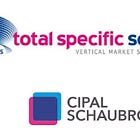TSS Closes Cipal Schaubroeck Acquisition
Plus: adding to an overweight position, and discussing Harvia's product innovation and OPEX structure
Welcome to a portfolio news digest to stay informed about everything that’s going on at our companies!
FYI: this week, we’ll publish the final part of our four-part series on sustainable quality compounding.
The main objective of a portfolio news digest is:
to talk about relevant company news that leads to broader discussions and;
to elaborate on premium members’ questions around recent trends/events.
Today’s Topics
Today, we’ll talk about Topicus’/TSS’ announcement on the closed Cipal Schaubroeck deal and tweak our model (the financial impact was already accounted for, but we can now reflect the exact timing).
Additionally, we’ll address Harvia’s recent product innovation, and provide additional color on the company’s current OPEX structure and the impact from growth investments on reported profitability. Our valuation model considers total cash flow generation, growth, and an exit multiple on steady-state NOPAT. Free cash flow and total growth is a function of ROIIC and reinvestment rate. We’ve elaborated on NOPAT in previous blogs and presentations.
Also, we’ll be adding to one of our existing overweight positions later today.
Adjusted Valuation Multiples - Growth OPEX
Narrowly defining steady-state NOPAT boils down to:
The pile of cash a company would have if it 1) stopped reinvesting for future growth, and 2) made only maintenance investments, both in physical assets (machinery, factories, leased assets (lease repayments) and intangibles (IT, capitalized R&D). Think of it like a fixed coupon you’re getting from fixed income investments. And so it happens that quality growth companies are worth a lot more than what their current P/E, FCF Yield suggests… as growth investments depress their reported earnings and FCFs.
Now, this is the very narrow definition. We typically only consider recurring NOPAT based on recurring D&A (it's easier to see/model), and don't make a distinction based on above-average OPEX. The fact is that, for most companies operating in a fairly competitive industry, higher OPEX are oftentimes a necessity to protect their brand equity and thus fend off competition/maintain market share and the steady-state revenue stream.
Normalizing or adjusting for all kinds of so-called growth expenses would leave us with a substantially lower valuation, to the point where it might seem as though any price is justified for a high-quality compounder. The hindsight bias of cherrypicking occasions where it could have made sense was discussed in the below blog.
Now, with this intermezzo, let’s get on with yesterday’s TSS/Topicus announcement.
TSS Insights
We've previously commented on this deal, which until yesterday was still pending regulatory approval.
Also, the total consideration (paid and to be paid) was already included in CSI's and TOI's open M&A commitments at the end of Q1 2025.
CSI’s M&A Capital Deployment (excl. Asseco, which is accounted for as a financial investment) - The Compounding Tortoise
As such, this is no big reveal of a new large deal that wasn’t reflected in our model yet. However, given that the timing is now known, we can fine-tune the assumptions for FY25 and FY26.






